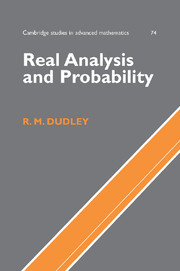Book contents
- Frontmatter
- Contents
- Preface to the Cambridge Edition
- 1 Foundations; Set Theory
- 2 General Topology
- 3 Measures
- 4 Integration
- 5 Lp Spaces; Introduction to Functional Analysis
- 6 Convex Sets and Duality of Normed Spaces
- 7 Measure, Topology, and Differentiation
- 8 Introduction to Probability Theory
- 9 Convergence of Laws and Central Limit Theorems
- 10 Conditional Expectations and Martingales
- 11 Convergence of Laws on Separable Metric Spaces
- 12 Stochastic Processes
- 13 Measurability: Borel Isomorphism and Analytic Sets
- Appendix A Axiomatic Set Theory
- Appendix B Complex Numbers, Vector Spaces, and Taylor's Theorem with Remainder
- Appendix C The Problem of Measure
- Appendix D Rearranging Sums of Nonnegative Terms
- Appendix E Pathologies of Compact Nonmetric Spaces
- Author Index
- Subject Index
- Notation Index
- References
11 - Convergence of Laws on Separable Metric Spaces
Published online by Cambridge University Press: 06 July 2010
- Frontmatter
- Contents
- Preface to the Cambridge Edition
- 1 Foundations; Set Theory
- 2 General Topology
- 3 Measures
- 4 Integration
- 5 Lp Spaces; Introduction to Functional Analysis
- 6 Convex Sets and Duality of Normed Spaces
- 7 Measure, Topology, and Differentiation
- 8 Introduction to Probability Theory
- 9 Convergence of Laws and Central Limit Theorems
- 10 Conditional Expectations and Martingales
- 11 Convergence of Laws on Separable Metric Spaces
- 12 Stochastic Processes
- 13 Measurability: Borel Isomorphism and Analytic Sets
- Appendix A Axiomatic Set Theory
- Appendix B Complex Numbers, Vector Spaces, and Taylor's Theorem with Remainder
- Appendix C The Problem of Measure
- Appendix D Rearranging Sums of Nonnegative Terms
- Appendix E Pathologies of Compact Nonmetric Spaces
- Author Index
- Subject Index
- Notation Index
- References
Summary
So far we have dealt with convergence of laws mainly on finite-dimensional Euclidean spaces ℝk, for the central limit theorem (§§9.3–9.5). Now we'll treat converging laws on more general, possibly infinite-dimensional spaces. Here are some cases where such spaces and laws can be helpful.
Let x(t, Ω) be the position of a randomly moving particle at time t, where Ω ∈ Ω, for some probability space (Ω, , P). For each Ω, we then have a continuous function t↦ x(t, Ω). Suppose we consider times t with 0 ≤ t ≤ 1 and that x is real-valued (the particle is moving along a line, or we just consider one coordinate of its position). Then x(·, Ω) belongs to the space C[0, 1] of continuous real-valued functions on [0, 1]. The space C[0, 1] has a usual norm, the supremum norm |f| ≔, sup|f(t)|: 0 < t < 1. Then C[0, 1] is a complete separable metric space for the metric d defined as usual by d(f, g) ≔, |f – g|. It may be useful to approximate the process x, for example, by a process yn such that for each Ω and each k = 1, …, n, yn (·, Ω) is linear on the interval [(k – 1)/n, k/n]. Thus it may help to define yn converging to x in law (or in probability or a.s.) in C[0, 1].
- Type
- Chapter
- Information
- Real Analysis and Probability , pp. 385 - 438Publisher: Cambridge University PressPrint publication year: 2002



